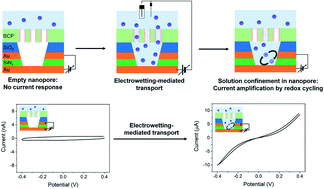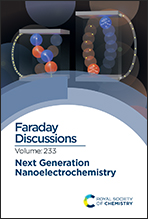Potential-induced wetting and dewetting in pH-responsive block copolymer membranes for mass transport control†
Abstract
Wetting and dewetting behavior in channel-confined hydrophobic volumes is used in biological membranes to effect selective ion/molecular transport. Artificial biomimetic hydrophobic nanopores have been devised utilizing wetting and dewetting, however, tunable mass transport control utilizing multiple transport modes is required for applications such as controllable release/transport, water separation/purification and energy conversion. Here, we investigate the potential-induced wetting and dewetting behavior in a pH-responsive membrane composed of a polystyrene-b-poly(4-vinylpyridine) (PS-b-P4VP) block copolymer (BCP) when fabricated as a hierarchically-organized sandwich structure on a nanopore electrode array (NEA), i.e. BCP@NEA. At pH < pKa(P4VP) (pKa ∼ 4.8), the BCP acts as an anion-exchange membrane due to the hydrophilic, protonated P4VP cylindrical nanodomains, but at pH > pKa(P4VP), the P4VP domains exhibit charge-neutral, hydrophobic and collapsed structures, blocking mass transport via the hydrophobic membrane. However, when originally prepared in a dewetted condition, mass transport in the BCP membrane may be switched on if sufficiently negative potentials are applied to the BCP@NEA architecture. When the hydrophobic BCP membrane is introduced on top of 2-electrode-embedded nanopore arrays, electrolyte solution in the nanopores is introduced, then isolated, by exploiting the potential-induced wetting and dewetting transitions in the BCP membrane. The potential-induced wetting/dewetting transition and the effect on cyclic voltammetry in the BCP@NEA structures is characterized as a function of the potential, pH and ionic strength. In addition, chronoamperometry and redox cycling experiments are used to further characterize the potential response. The multi-modal mass transport system proposed in this work will be useful for ultrasensitive sensing and single-molecule studies, which require long-time monitoring to explore reaction dynamics as well as molecular heterogeneity in nanoconfined volumes.

- This article is part of the themed collection: Next Generation Nanoelectrochemistry


 Please wait while we load your content...
Please wait while we load your content...
